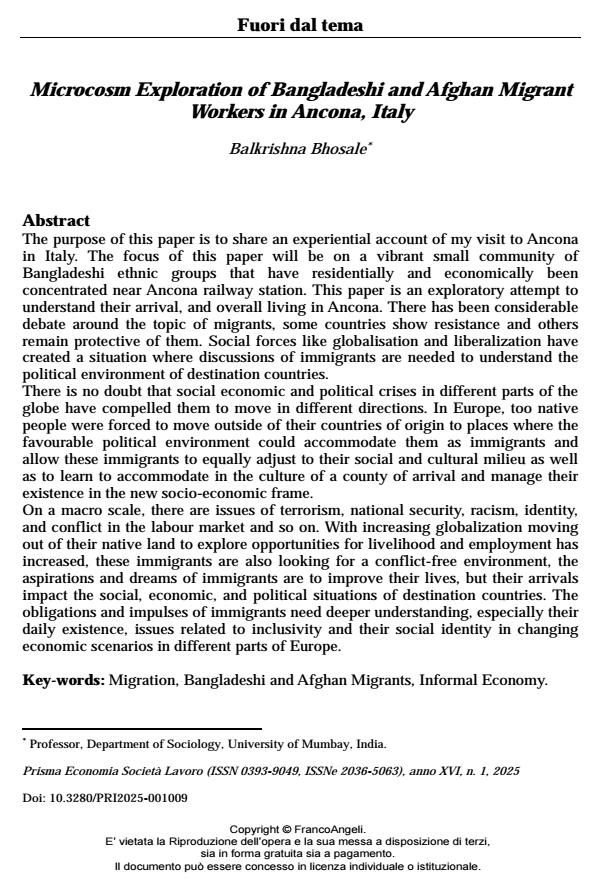Microcosm Exploration of Bangladeshi and Afghan Migrant Workers in Ancona, Italy
Titolo Rivista PRISMA Economia - Società - Lavoro
Autori/Curatori Balkrishna Bhosale
Anno di pubblicazione 2025 Fascicolo 2025/1
Lingua Inglese Numero pagine 15 P. 103-117 Dimensione file 146 KB
DOI 10.3280/PRI2025-001009
Il DOI è il codice a barre della proprietà intellettuale: per saperne di più
clicca qui
Qui sotto puoi vedere in anteprima la prima pagina di questo articolo.
Se questo articolo ti interessa, lo puoi acquistare (e scaricare in formato pdf) seguendo le facili indicazioni per acquistare il download credit. Acquista Download Credits per scaricare questo Articolo in formato PDF

FrancoAngeli è membro della Publishers International Linking Association, Inc (PILA)associazione indipendente e non profit per facilitare (attraverso i servizi tecnologici implementati da CrossRef.org) l’accesso degli studiosi ai contenuti digitali nelle pubblicazioni professionali e scientifiche
The purpose of this paper is to share an experiential account of my visit to Ancona in Italy. The focus of this paper will be on a vibrant small community of Bangladeshi ethnic groups that have residentially and economically been concentrated near Ancona railway station. This paper is an exploratory attempt to understand their arrival, and overall living in Ancona. There has been considerable debate around the topic of migrants, some countries show resistance and others remain protective of them. Social forces like globalisation and liberalization have created a situation where discussions of immigrants are needed to understand the political environment of destination countries. There is no doubt that social economic and political crises in different parts of the globe have compelled them to move in different directions. In Europe, too native people were forced to move outside of their countries of origin to places where the favourable political environment could accommodate them as immigrants and allow these immigrants to equally adjust to their social and cultural milieu as well as to learn to accommodate in the culture of a county of arrival and manage their existence in the new socio-economic frame. On a macro scale, there are issues of terrorism, national security, racism, identity, and conflict in the labour market and so on. With increasing globalization moving out of their native land to explore opportunities for livelihood and employment has increased, these immigrants are also looking for a conflict-free environment, the aspirations and dreams of immigrants are to improve their lives, but their arrivals impact the social, economic, and political situations of destination countries. The obligations and impulses of immigrants need deeper understanding, especially their daily existence, issues related to inclusivity and their social identity in changing economic scenarios in different parts of Europe.
Parole chiave:Migration, Bangladeshi and Afghan Migrants, Informal Economy.
Balkrishna Bhosale, Microcosm Exploration of Bangladeshi and Afghan Migrant Workers in Ancona, Italy in "PRISMA Economia - Società - Lavoro" 1/2025, pp 103-117, DOI: 10.3280/PRI2025-001009